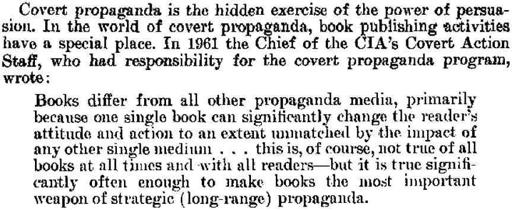Impossible: The Case Against Lee Harvey Oswald (21 page)
Read Impossible: The Case Against Lee Harvey Oswald Online
Authors: Barry Krusch
Tags: #Non-Fiction, #History
As mentioned, this final point was the potential Achilles heel of the entire enterprise. Recall that college students have been recruited. One of the arguments against conspiracy “theories” is that “someone would have talked” (and that therefore since no one talked, there was no conspiracy), yet obviously this was no concern for the
Northwood
authors. What did they know that we don’t?
Perhaps they knew they had
control of media
, and therefore the ability to control leaks. Perhaps they were aware that agencies such as FBI and CBI had “counterintelligence” programs with the ability and experience to manufacture
news
in the same way the Joint Chiefs could manufacture a
geopolitical crisis
!
Recall that the Military and the CIA are working hand-in-hand. If the Military and the CIA had control of the media, then their scheme was safe from prying eyes.
Control of this nature would, by its nature, involve a good deal of coordination from network to network, from magazine to magazine, from newspaper to newspaper. Hugh Wilford wrote a book on this very topic. The title says it all:

The genesis of the term, according to Wilford, was as follows (
Mighty Wurlitzer
, p. 7; footnote omitted):
The CIA constructed an array of front organizations that Frank Wisner, the Agency’s first chief of political warfare, liked to compare to a “Mighty Wurlitzer” organ, capable of playing any propaganda tune he desired.
If you don’t have time to read the Wilford book, but still want to know how the pipes of the organ work in concert, all you need to do is read the following excerpts from a report created by the Church Committee in 1975 and 1976 to investigate the intelligence agencies, a committee which, apart from including Frank Church, included political luminaries from both sides of the political spectrum such as Walter Mondale, Gary Hart, Howard Baker, Barry Goldwater, and Richard Schweiker.
Data describing the operation of the Wurlitzer was found in Book 1 of their report, titled
Foreign And Military Intelligence
, in particular Chapter 10 titled “The Domestic Impact Of Foreign Clandestine Operations: The CIA And Academic Institutions, The Media, And Religious Institutions,” to be cited hereinafter as 1 CCR.
The basic concept of the Wurlitzer (or
matrix
, to use another, related term), is to
control the flow of information
through a network of academics, foundations, publishers, and mass media in general, information flowing downhill and eventually resulting in a “hall of mirrors”, echo chamber effect where people only report what other people are reporting. As we learned from the Asch effect, if multiple sources report the
same
false information, people see that false information as
reality
. If reality is defined as what people
report
, defining
what
people report is all you need to do.
Here is how the Wurlitzer might look today:

Unfortunately, that metaphor is
linear
, when the actual information path would most likely be
hierarchical
(bottom-up or top-down, depending on your orientation). The best way to control the flow of information is to first control the
source
of information, academics located at universities, the fountainhead from which our knowledge well bubbles, and the role of these academics is to not only
report
the information which is “approved”, but also to
lend prestige
to that information, to legitimize it: information which is
not
discussed appears illegitimate because it seems to be a minority, “fringe” view not worthy of discussion by the best and the brightest (1 CCR 189-90):

While academics generally knew of CIA involvement (and most likely signed “nondisclosure” agreements to not disclose the source of their funds), on other occasions academics could receive grants to do “approved” work without knowing that the CIA was the source (1 CCR 181):

The grants designed to steer the academics in the “right” direction were provided by numerous foundations: as the Committee reported, of 700 large grants, at least 108 involved “partial or complete CIA funding” (1 CCR 182):

With the
source
of information controlled, the next step would be to control the
output
of that source, which could be op-ed pieces in newspapers, articles in journals or magazines, or simply books (1 CCR 192-93):

This was no Mickey Mouse operation: well over 1000 books were produced by the CIA’s “knowledge” factory (1 CCR 193):

These books could be authored on nearly any topic, depending on the need of the day.
Say some renegade JFK assassination author finds evidence implicating your organization, the CIA, in the assassination of President Kennedy. Because the author has evidence, you cannot implicate him directly as a “nut job”, but what you can do is lump him in the same category as an author with an identical thesis on that point, as well as an additional discredited “nut job ready” thesis.
So, let’s say you want to discredit this line of JFK research; all you have to do is find an author who postulates viable thesis X and ridiculous thesis Y, and then give
that
author a book contract (not the other guy). There is no need to work with author NJ directly, because you know what he or she is going to say in advance. For example, you might even publish a book like this:

Now,
was
this book published in 2011 sponsored by the CIA in some way, shape or form for the purpose I described? We have no idea. However, what we
do
know is numerous books authored in the 1960s and 70s
were
sponsored by the CIA, without the knowledge of the Americans reading them. One such book was supposedly written by a “Chinese defector” (1 CCR 199):
